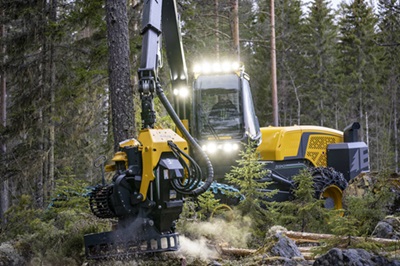
This allows for lower capital cost mulching for specialised operations.
The development behind the cabin is one of Eco Log´s longest projects so far and the road has been lined with quite a few challenges. Also, it has been a learning process to many parts of the company. The new harvesters in the G series are now waiting for production to start in 2024.
Behind the decision to develop a new harvester cabin are several factors. Future regulations, new design possibilities and, not the least, the demands and requests from the customers was finally decisive and a first pilot study was started in summer 2017.
To develop an entirely new cabin is, to say the least, an extensive task and the factors to consider are many. In a pilot study, all input from the market is gathered with a variety of different parameters, such as manufacturing costs, legal requirements, technical limitations, choice of suppliers and the conditions to manufacture and produce the product in an efficient way. Of course, the operator comes first regarding visibility, ergonomics, comfort and functionality.
When the development work really starts there are a variety of thorough tests and simulations that must be conducted to ensure that everything from climate, materials and electronics to visibility and, above all, safety is well functioning and meets various requirements and standards. A slightly different customer request was the turnable seat where the main reason was to create a space for having lunch without sitting with the food in your lap. This solution has then resulted in several advantages. As an example, there is plenty of space behind the seat to store your cooler bag or lunch bag and one can also spin the seat to get out of the cabin more easily. Another advantage is an easier service. Now, one can turn the seat around and easily access fuses, relays, diagnostic sockets and many other things that are placed under the panels behind the operator.
Storage possibilities is a recurring request from the customers and Eco Log´s development department has put a lot of effort to find smart storage solutions – a task that comes with a lot of challenges. The cabin must also accommodate large amounts of electronics, a ventilation system suited both for summer and winter, noise isolation and now, the rotating seat.
A special carriage was manufactured to be able to move the cabin between different tests. Eco Log performed many calculations on solidity and the possibilities to get out of the cabin in case of an accident. To verify all the calculations a number of cabins were tested. We simulate that a machine turns over (ROPS), they release a large steel ball onto the cabin to simulate a falling tree (FOPS); and ensure that the front windshield is resistant to chain shots. Also, OPS tests are carried out to make sure that the operator can´t be injured by example logs or other objects.
The cabin has a new HVAC system. The preparations of the climate tests are made in a simulation program, both regarding air flow and capacity for heating and cooling. The optimized result could then be 3D printed and tested in the first prototype cabin. There are also requirements deciding how a cabin should be cooled without causing air drafts around ones neck. This also applies to heating and the possibility to have windows free from condensation. The requirements today states that it can only differ a maximum of five degrees between head and foot for the operator. The cabin climate also includes floor heating, a newly developed system that has been thoroughly tested for an optimal temperature. Electric heating coils under the rubber mat makes snow and water dry quickly and gives a comfortable temperature to your feet or to your dog accompanying you in the machine. The challenge with floor heating is to create a system that provides a heated area that is as large as possible and in the same time safe to walk on and install without risk of causing damages to the system when handling the chair.
The choice of different materials has also been tested, amongst others to see how the sun´s rays affect. Tests were performed in an UV chamber for more than 1000 hours, which according to standard is equal to approximately ten years of exposure of the sun. The UV-affected material was also brushed with hydraulic oil to see if that could have an impact on the lifespan of the material. Through these tests, some materials could be excluded, and others selected for use in a forest machine.
Many tests have also been carried out on the key-less system, both regarding the placement of antennas in the cabin, but also regarding functionality and reliability. The sensor for locking and unlocking have been tested to ensure that it works even if you are wearing gloves, if it rains or is cold outside. The key has been tested regarding reach, but has also been put down in mud to ensure that you can drop it in your tracks and still get into the cabin. Source